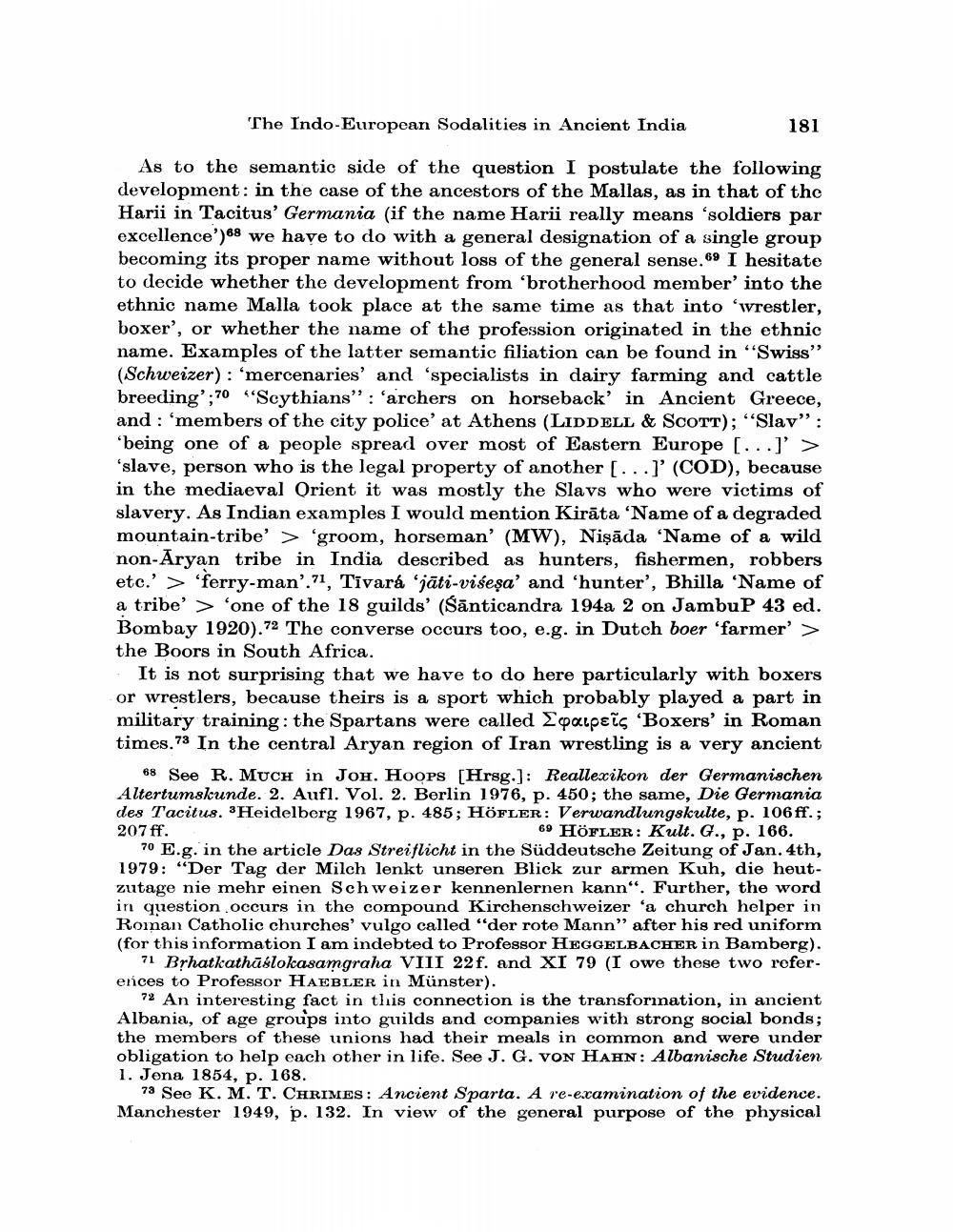________________
The Indo-European Sodalities in Ancient India
181
As to the semantic side of the question I postulate the following development: in the case of the ancestors of the Mallas, as in that of the Harii in Tacitus' Germania (if the name Harii really means 'soldiers par excellence') 68 we have to do with a general designation of a single group becoming its proper name without loss of the general sense.69 I hesitate to decide whether the development from 'brotherhood member' into the ethnic name Malla took place at the same time as that into 'wrestler, boxer', or whether the name of the profession originated in the ethnic name. Examples of the latter semantic filiation can be found in ''Swiss" (Schweizer): 'mercenaries' and 'specialists in dairy farming and cattle breeding';70 “Scythians" : 'archers on horseback' in Ancient Greece, and : members of the city police' at Athens (LIDDELL & SCOTT); "Slav": 'being one of a people spread over most of Eastern Europe [...]' > ‘slave, person who is the legal property of another [...]' (COD), because in the mediaeval Orient it was mostly the Slavs who were victims of slavery. As Indian examples I would mention Kirāta 'Name of a degraded mountain-tribe' > 'groom, horseman' (MW), Nişāda "Name of a wild non-Aryan tribe in India described as hunters, fishermen, robbers etc.' > 'ferry-man'.71, Tīvará "jāti-višeşa' and 'hunter', Bhilla 'Name of a tribe' > 'one of the 18 guilds' (sānticandra 194a 2 on JambuP 43 ed. Bombay 1920).72 The converse occurs too, e.g. in Dutch boer 'farmer' > the Boors in South Africa.
It is not surprising that we have to do here particularly with boxers or wrestlers, because theirs is a sport which probably played a part in military training: the Spartans were called palpets 'Boxers' in Roman times.73 In the central Aryan region of Iran wrestling is a very ancient
68 See R. MUCH in Joh. Hoops (Hrsg.): Reallexikon der Germanischen Altertumskunde. 2. Aufl. Vol. 2. Berlin 1976, p. 450; the same, Die Germania des Tacitus. Heidelberg 1967, p. 485; HÖFLER: Verwandlungskulte, p. 106 ff.; 207 ff.
69 HÖFLER: Kult. G., p. 166. 70 E.g, in the article Das Streiflicht in the Süddeutsche Zeitung of Jan. 4th, 1979: "Der Tag der Milch lenkt unseren Blick zur armen Kuh, die heutzutage nie mehr einen Schweizer kennenlernen kann". Further, the word in question occurs in the compound Kirchenschweizer 'a church helper in Roman Catholic churches' vulgo called "der rote Mann" after his red uniform (for this information I am indebted to Professor HEGGELBACHER in Bamberg).
71 Brhatkathāślokasamgraha VIII 22f. and XI 79 (I owe these two references to Professor HAEBLER in Münster).
72 An interesting fact in this connection is the transformation, in ancient Albania, of age groups into guilds and companies with strong social bonds; the members of these unions had their meals in common and were under obligation to help each other in life. See J. G. VON HAHN: Albanische Studien 1. Jena 1854, p. 168.
73 See K. M. T. CHRIMES: Ancient Sparta. A re-examination of the evidence. Manchester 1949, p. 132. In view of the general purpose of the physical




